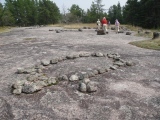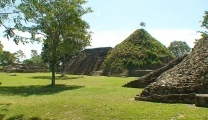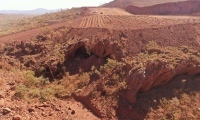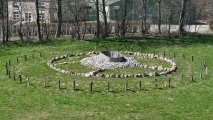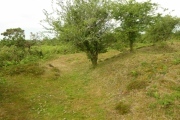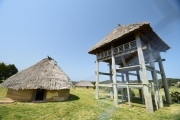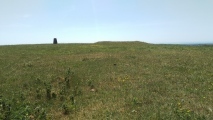Andy Burnham's Blog, page 195
June 11, 2020
Bannock Point Petroforms
The Bannock Point Petroforms are located in Whiteshell Provincial Park located on #307 Road in Manitoba. Bannock Point features Petroforms which are stones laid out on the bedrock in the shapes of Turtles, Snakes, geometric forms and a Thunderbird. They are thought to have been made centuries ago by First Nations people for their value in teaching and healing ceremonies and are still considered sacred to this day.
Published on June 11, 2020 07:24
Moral-Reforma
The Moral-Reforma site had a long occupation from 300 BC until 1000 AD, initially as a village-type settlement that gradually gained regional importance as a center that controlled traffic on the San Pedro Mártir river bed, through which communication and the exchange of goods between the Mayan peoples of the Guatemalan Petén and those settled on the shores of the Gulf of Mexico.
Published on June 11, 2020 07:19
Pibara Petroglyphs
Mining giant BHP Billiton is poised to destroy at least 40 - and possibly as many as 86 - significant Aboriginal sites in the central Pilbara, Western Australia to expand its $4.5bn South Flank iron ore mining operation, even though its own reports show it is aware that the traditional owners are deeply opposed to the move. Photo left: 46,000 year old Rock Shelter site destroyed in a blast to expand the Brockman 4 iron ore mine last month.
Published on June 11, 2020 05:21
June 10, 2020
Hjulgraven i Hjordkær
In 1978 the local municipalities wanted to clear some ploughed-down tumuli in order to develop an industrial area. The local museum, which specialises in archaeology, was asked to supervise an excavation of what proved to be the unique late Neolithic Wheel-Grave, one of a kind in Denmark. The wheel-grave is named after the stone circle that formed the base of the inner barrow. More than 4.000 years ago, it was built directly on the surface of the field as a stone circle with a diameter of 9-10 m. From the stone circle five stone-rows (one of them double) radiates like spokes from a hub.
Published on June 10, 2020 06:38
Tobiæ Kilde
The mirror of water is still under the beech trees, but from the bottom a well trickles. According to local folklore the water can cure eye diseases. From pre-Christian times the well has been considered sacred, and because of its special healing power, it was named after St. Tobiæ after the introduction of Christianity. In Midtjylland, Denmark
Published on June 10, 2020 06:29
Second Roborough Down Earthworks
This is a circular earth work approximately 15m diameter. It is located on Roborough Down about 200m ESE of the main Roborough Down Earthwork (see nearby sites on our page), on the Eastern side of the A386. It is a short walk from a nearby car park and the immediately surrounding gorse, bracken and brambles are trimmed by somebody so that it is accessible and visible.
Published on June 10, 2020 06:27
June 8, 2020
Oni-no-Iwaya Kofun (Iki island)
A round tumulus (45m alt.). Often mistaken for Oniyakubo Kofun with ship engravings (see nearby sites). Although this tumulus has no engravings its grand chamber is worth visiting. Oni-no-Iwaya means the cave of giant ogre (=oni).
Published on June 08, 2020 07:34
Haru-no-Tsuji Iseki
The ruin of the capital of the ancient (2-4c CE) kingdom known as Iki-koku or "Iki-no-kuni". Grains of rice and wheat, bone of livestock and fishes, pottery, beads, medals and a pebble with facial features were excavated. A museum and a learning facility are attached. On Iki island which lies between Korean peninsula and Kyūshū island.
Published on June 08, 2020 07:33
June 7, 2020
Blackpatch Hill Bowl Barrow
Bowl barrow , 10.5 in diameter, 0.6m in height.
No trace of a ditch. Situated in pasture on the highest part
of Blackpatch Hill
No trace of a ditch. Situated in pasture on the highest part
of Blackpatch Hill
Published on June 07, 2020 07:24
June 6, 2020
Tossen-Keler Cromlech (post 2018)
The 40 metre diameter and 10 metres high Tossen Keller tumulus from south of Penvénan was excavated and totally removed in the early 1960's. The horseshoe of stones (cromlech) that surrounded it were moved initially to the quayside at Tréguier, and again in June 2018 to the grounds surrounding the chapel of Saint Gonval. (see the photo further down our page)
Published on June 06, 2020 06:51

